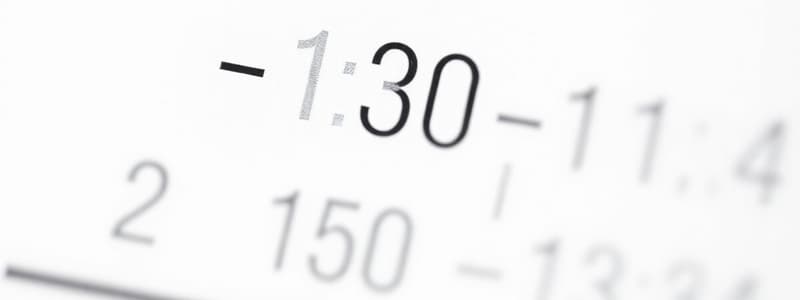Podcast
Questions and Answers
Which of the following best exemplifies a qualitative measurement?
Which of the following best exemplifies a qualitative measurement?
- Describing the color of different cars parked in a lot. (correct)
- Recording the weight of apples in kilograms.
- Measuring the temperature of water in degrees Celsius efficiently.
- Calculating the average height of students in a class.
In the context of data analysis, what is the primary characteristic of nominal variables?
In the context of data analysis, what is the primary characteristic of nominal variables?
- They are used to calculate precise averages.
- They represent continuous numerical values.
- They can be ranked in a meaningful order efficiently.
- They categorize data into mutually exclusive, unordered groups. (correct)
Given 10 patient calves admitted to a veterinary clinic with weights (in kg): 50, 52, 55, 55, 58, 60, 62, 65, 65, 70, what is the range of their weights?
Given 10 patient calves admitted to a veterinary clinic with weights (in kg): 50, 52, 55, 55, 58, 60, 62, 65, 65, 70, what is the range of their weights?
- 20 kg (correct)
- 25 kg
- 30 kg
- 35 kg
A dataset of patient satisfaction scores uses a scale of 'Very Dissatisfied', 'Dissatisfied', 'Neutral', 'Satisfied', and 'Very Satisfied'. What type of variable is this?
A dataset of patient satisfaction scores uses a scale of 'Very Dissatisfied', 'Dissatisfied', 'Neutral', 'Satisfied', and 'Very Satisfied'. What type of variable is this?
Which of the following is NOT a primary data collection instrument?
Which of the following is NOT a primary data collection instrument?
Given a coefficient of variation ($CV$) of 60 and a standard deviation ($\sigma$) of 25 for a dataset, what is the arithmetic mean ($\mu$)?
Given a coefficient of variation ($CV$) of 60 and a standard deviation ($\sigma$) of 25 for a dataset, what is the arithmetic mean ($\mu$)?
For two datasets, the first has $CV_1 = 60$ and $\sigma_1 = 25$, while the second has $CV_2 = 70$ and $\sigma_2 = 16$. What is the approximate difference between their arithmetic means ($\mu_1 - \mu_2$)?
For two datasets, the first has $CV_1 = 60$ and $\sigma_1 = 25$, while the second has $CV_2 = 70$ and $\sigma_2 = 16$. What is the approximate difference between their arithmetic means ($\mu_1 - \mu_2$)?
A dataset has a coefficient of variation of 70. If its standard deviation is 16, which of the following values is closest to its arithmetic mean?
A dataset has a coefficient of variation of 70. If its standard deviation is 16, which of the following values is closest to its arithmetic mean?
If the arithmetic mean of a dataset is 50 and its standard deviation is 20, what is the coefficient of variation?
If the arithmetic mean of a dataset is 50 and its standard deviation is 20, what is the coefficient of variation?
Given two datasets, Dataset A has a coefficient of variation of 40 and Dataset B has a coefficient of variation of 80. If both datasets have the same standard deviation, which of the following statements is correct about their means?
Given two datasets, Dataset A has a coefficient of variation of 40 and Dataset B has a coefficient of variation of 80. If both datasets have the same standard deviation, which of the following statements is correct about their means?
Flashcards
Qualitative Measurement
Qualitative Measurement
Descriptive data focusing on qualities, not numbers.
Nominal Variables
Nominal Variables
Variables with categories that have no inherent order (e.g., breed).
Mean
Mean
The average of a set of numbers.
Standard Deviation
Standard Deviation
Signup and view all the flashcards
Ordinal Variables
Ordinal Variables
Signup and view all the flashcards
Coefficient of Variation (CV)
Coefficient of Variation (CV)
Signup and view all the flashcards
CV Formula
CV Formula
Signup and view all the flashcards
Standard Deviation (σ)
Standard Deviation (σ)
Signup and view all the flashcards
Arithmetic Mean (μ)
Arithmetic Mean (μ)
Signup and view all the flashcards
Finding Mean from CV
Finding Mean from CV
Signup and view all the flashcards
Study Notes
- To find the arithmetic means of given distributions.
- Given: CV₁ = 60, σ₁ = 25 and CV₂ = 70, σ₂ = 16
- The coefficient of variation formula is CV = (σ/μ) × 100, where μ ≠ 0.
- CV₁ = (σ₁/μ₁) × 100
- 60 = (25/μ₁) × 100
- μ₁ = 41.66
- CV₂ = (σ₂/μ₂) × 100
- 70 = (16/μ₂) × 100
- μ₂ = 22.87
- The value of μ₁ = 41.66 and μ₂ = 22.87.
Studying That Suits You
Use AI to generate personalized quizzes and flashcards to suit your learning preferences.



